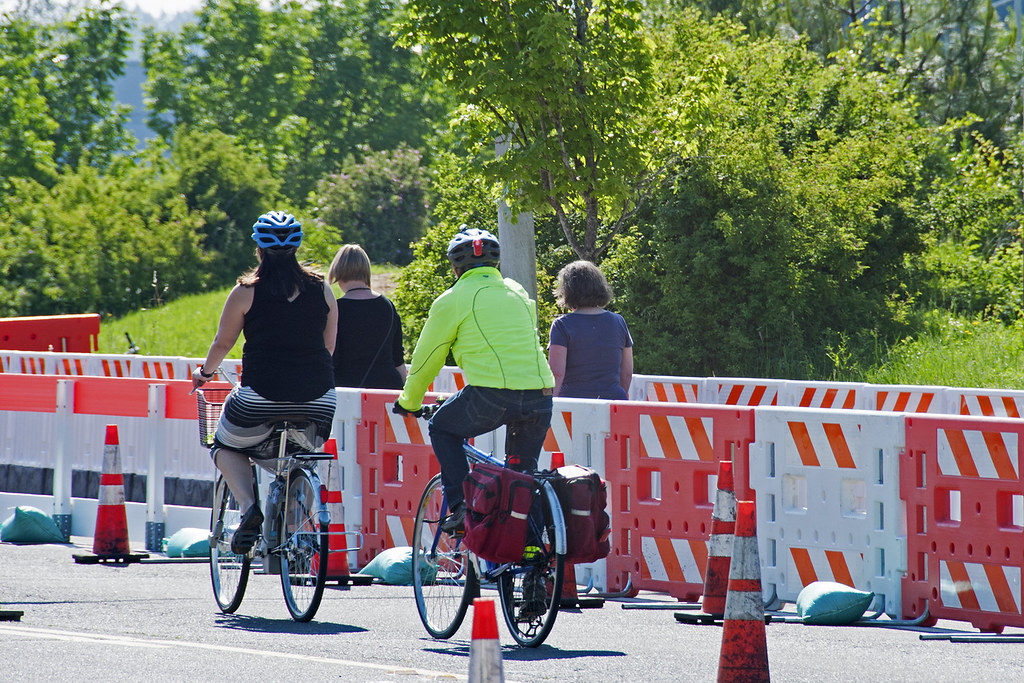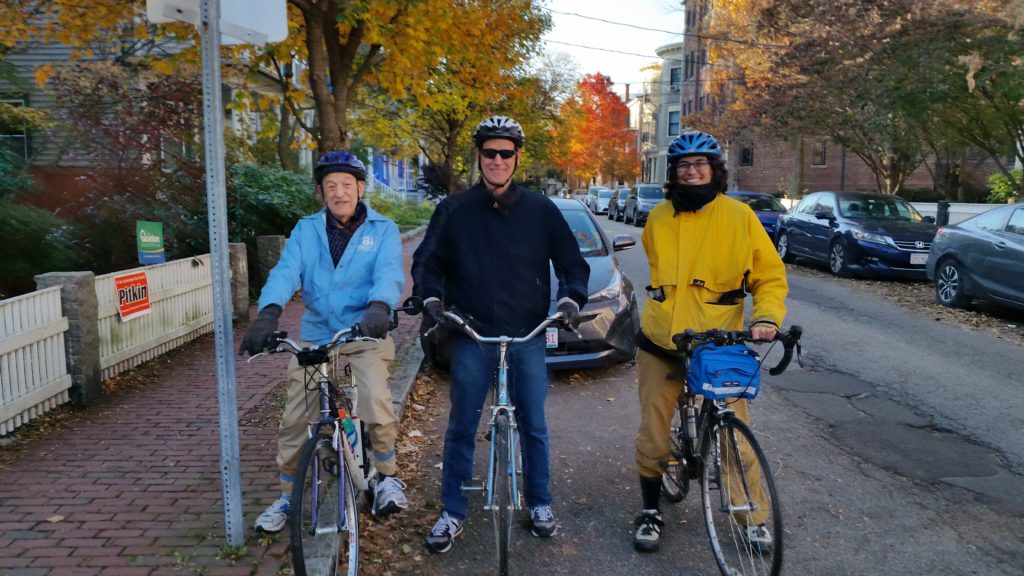TOWN SETS TRANSPORTATION PRIORITIES

Have you ever wished your neighborhood were safer to walk in? Have you longed for off-road sidewalks or paths you or your kids could use to bike to school, work, or the store? Are you a business owner who likes it when people get out of their cars and walk or bike by, slow and close enough that they notice your retail space (preferably without too much walking-and-texting – or worse, riding-and-texting)? Do you depend on transit but find some bus stops, routes and schedules to be unsafe, inconvenient, or simply unavailable?
If any of these have been concerns for you – and my experience volunteering on transportation in Amherst for nearly a decade suggests they are concerns for most Amherst residents – then I have some good news. The Town of Amherst is moving toward a much stronger network of pedestrian, bicycle and transit facilities. No, unfortunately, it’s not moving nearly as fast as many of you would like. But, it’s moving. And, you have a chance to play a part.
This is the first in a planned three-part series for The Amherst Indy on what’s happening on pedestrian, bicycle and transit planning in Amherst’s Transportation Advisory Committee. This first article gives you a bit of background, and a heads-up about things to come.
Background
(If you want to skip to the more exciting news, scroll ahead to “What’s Happening Now.”)
1. The Transportation Advisory Committee (TAC) is a town committee that advises the Town Council, the Town Manager, and the Superintendent of Public Works. What does the TAC do and care about? Both the TAC’s official charge and its vision statement are on its website. The short version is: the TAC works to advise on all things related to transportation, and we seek to do this in a comprehensive way that is responsive to residents’ concerns and requests, and provides all of you with a single place to go for transportation concerns. Our vision includes an emphasis on improving multi-modal transportation, and we see this as linked to a wide variety of benefits for the town
Our activities over the last several years have emphasized building toward robust bicycle, pedestrian and transit networks that can serve anyone, and safe walking neighborhoods throughout the town. Most resident requests that have come into us have been requests for improvements in pedestrian safety and facilities, and/or bicycle network improvements.
2. Unfortunately, a big charge and vision like these are more quickly passed than implemented, especially with an all-volunteer committee of members with busy lives. Still, over the last 5 years or so, the TAC, and its predecessors, have helped the town produce some key plans and policies, including:
· Amherst Transportation Plan (2015)
· Amherst Complete Streets Policy (2018)
· A draft Amherst Bicycle & Pedestrian Plan (2018)
3. There are many reasons for this (relative) flurry of activity. But one key is that Massachusetts is supporting an effort to improve routes for bicycle and pedestrian transportation in towns and cities across the Commonwealth. One effort is the Complete Streets program, which allows a municipality with a Complete Streets Policy (Amherst – check!) and a project prioritization list (on the way – see discussion below) to apply for grants. There are also now state-wide plans for pedestrian and bicycle transportation.
Why this enthusiasm for bikes and peds? One reason is carbon emissions. Massachusetts has some of the strongest laws in the country to reduce carbon emissions, and a Clean Energy and Climate Plan, which mandated that the Massachusetts reduce state-wide emissions by 25% between 1990 and 2020. Believe it or not, the state may well meet that goal by Dec 31 of this year. Much of that achievement rests on a reduction of emissions in electricity generation (largely from switching from coal and oil to gas, though energy conservation has also played a big part – and Amherst has been active there, too). Today, however, the economic sector with the highest emissions in Massachusetts is no longer electricity, but transportation. The Clean Energy and Climate Plan aims to reduce climate emissions 80% below 1990 levels by 2050, and this week, Governor Baker committed to reach net zero emissions statewide by that year. To reach these goals, we need to find ways to dramatically reduce people’s reliance on single occupancy gas-guzzling motor vehicles. Shifting a significant portion of short trips to bikes, peds, and transit can play a major role here.
There are many other reasons to support bicycling, walking and transit, but a summary from the Pioneer Valley Planning Commission may suffice: “active transportation has numerous cross-cutting benefits including improving neighborhood livability, reducing vehicle congestion, reducing air pollution, increasing climate change resiliency, supporting economic development, providing a more equitable transportation system, and facilitating public health.”
What’s Happening Now?.
The TAC’s current focus is developing a prioritization system for pedestrian, bicycle and transit projects. This means a system which can put proposed projects in order of priority in allocating inevitably limited funds and time. A prioritization system is important for a couple reasons. First, there are a lot of desired and worthwhile pedestrian, bicycle and transit projects that have been requested, all over town. In the past there’s been no objective process to decide among requested projects. Many requests have languished for years with no clear response, while others have been addressed relatively quickly. This un-systematic process has often favored squeaky-wheel (so to speak) projects, projects eligible for outside grants, and traditional uses of transportation funds. We want to develop a system that will prioritize the most important individual projects, while also building toward the robust multi-modal networks we want town-wide.
The second reason a prioritization system is important is that when towns have a Complete Streets Policy and a prioritization system, they become eligible for state Complete Streets funds.
The TAC subcommittee, which I chair, has been working on the prioritization system for months. There are two parts of the prioritization system we have been developing, each of which I will provide more detail on in future articles:
1. A series of matrices to score different projects based on criteria like “level of bicycle/pedestrian service” (which we have been defining), network improvements, safety, and timeliness/feasibility. This is a complex system, and normally would have been prepared by a consultant, but the subcommittee took it on in order to shape it best for Amherst needs. We have been aided by town staff, the Pioneer Valley Planning Commission, and subcommittee members who have been part of UMass Transportation Engineering and UMass Regional Planning. By the time we’re done, we hope it may become a rough model for other cities and towns.
2. Recommendations for how budget and administrative functions in town might be shifted or re-emphasized in order to support not just a prioritization of scarce funds and personnel, but an enlargement of resources in order to do more of the projects so many residents request, to build toward the robust bicycle, pedestrian and transit networks we want, and to improve neighborhood safety throughout town.
This winter, in almost every TAC meeting, the subcommittee is presenting a piece of our work on this to the TAC, and the TAC is fine-tuning.
If residents are interested in this process, the TAC usually meets on the second and fourth Wednesdays, around 5 PM, usually in the first floor meeting room of the Police Station. The TAC will have a public meeting about the prioritization system once we are done shaping our own ideas and recommendations, in about March or April.

Eve Vogel is a member of the Amherst Transportation Advisory Committee. This article is based on her personal work, understandings and opinions, and does not represent an official publication of the TAC.

While TAC plans, makes matrices, hires yet more consultants, crossing at the five-sided X in North Amherst seems to be on a very “back burner”… Out sight, out of mind, as some scholars say…
First, Eve this is a good article. Thanks for posting it.
I agree with Hilda about the dangerous North Amherst intersection. A right-turn lane through the now-closed driveway of the auto repair place just north of the N. Amherst Library would be an improvement. And please consider Henry Street! There is a lot of traffic cutting through to avoid the Pleasant Streets, big trucks rumbling through, and miniscule shoulders around sharp curves. Help! It is dangerous to walk and to bike.
But thanks to the Town for finally adding the missing stop sign at the bottom of Shutesbury Road at Henry.
That is my 89-year-old dad on the left, who still bikes weekly from Cambridge to Lexington and back on the Minuteman rail trail. Needless to say, we think his ability to do this is part of what has kept him healthy all these years.
Thanks, Eve, for letting the reading public know about the Amherst TAC’s plans for alternative transportation (“walk & roll & transit”) in the near and distant future (and for sharing the photo of your dad :-)). Planning and prioritization are important, but the timely realization of such plans — through the design and construction of actual projects — is at least as important.
Many notable alternative transportation facilities in the Amherst area — our extensive fare-free bus system, our network of on-road bike-lanes (many still unmarked and unenforced), the Norwottuck Rail Trail joining Northampton with Amherst, and on to UMass along the Swift Way paralleling University Drive — are proof that earlier generations of volunteers had also been hard at work planning and realizing municipal projects.
A bicycle can serve as an imperfect mechanical analogue for municipal government — please entertain this analogy for a moment:
Properly lubricated bearings (at both the axles and the steering head-set) is like good planning, guiding the implementation of new municipal projects with minimal friction; while listening to the “squeaky* wheels” is important, since it can help avoid more serious future problems, it’s even better to anticipate problems in advance with thorough yet flexible planning.
However, we also need strong pedals and cranks, gears and chains, spokes and tires, to transmit the motive power from rider to road: this is the advocacy for, management and oversight of municipal projects that have been identified as ready-to-go; some of these are stand-alone and need new appropriations of funds; others (like bike-lanes when a road is being resurfaced) can piggy-back on already-planned projects at little to no extra cost; as much as planning and prioritization may help with the former, the latter require the agility of volunteer committee members, the attentiveness of Town staff, and the political will of our elected officials.
A great deal of this agility, attentiveness and political will has decayed in recent years — much like our roads and our transit system, and like so much more of our municipal infrastructure.
This parallels a declining public participation in self-government, which went hand-in-hand with the abolition of Amherst Town Meeting and its strong system of volunteer committees advocating for these diverse and important public interests.
Will this decline in active advocacy at the committee levels be reversed? One hopes the work of the TAC hints that it will be….
[*already on display here in a few comments from our friends ;-)]
Thanks for your comments, Hilda, Eliza and Rob. I am hoping our conversations, and the TAC’s and Town’s work, can indeed “lubricate” the machine of town governance and transportation action, with some active and thoughtful citizen involvement. More in the next installment….